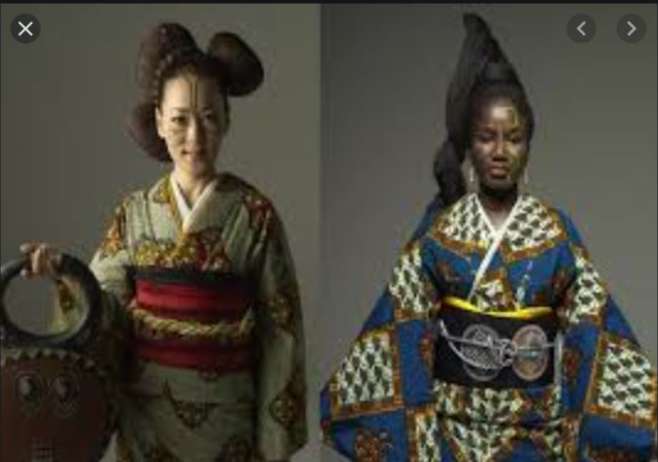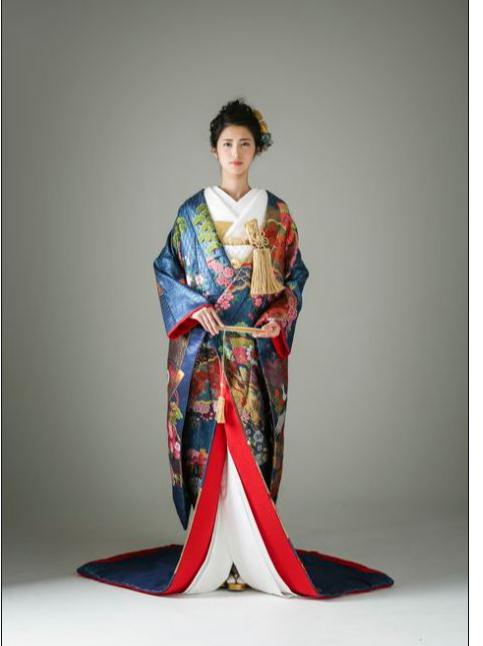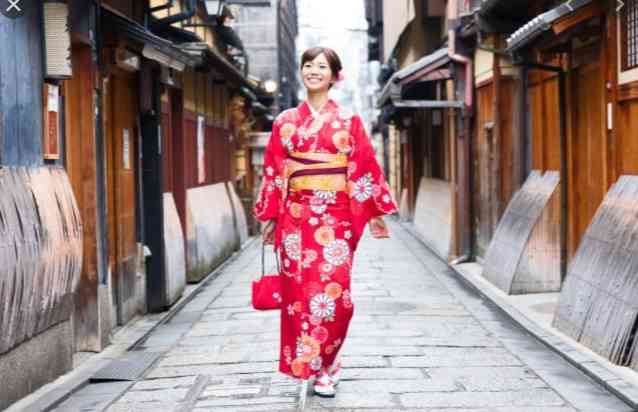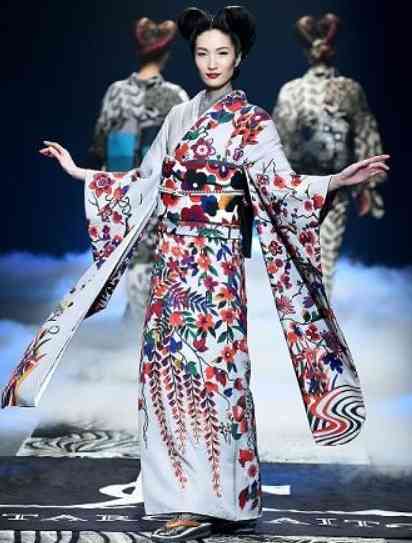The Japanese Kimono is perhaps one of the most recognised fashion garments from around the world. It’s distinctive in style and it also inspired the spectacular Orientalist fashion movement, which saw Westerners take an infatuated interest in Japanese and Ch!nese makeup, fashion, textiles and design during the 1920s. Meaning “the thing” when translated into English, the name almost has an air of sarcasm, similar to the tone of Hirai Terushichi’s paintings from the 1900s or even French painter René Magritte’s rendition of surrealism with C’est Est Une Pipe; but dig a little deeper and you’ll realise that there’s plenty of spiritualism attached to this popular garment and colour psychology can often be used to reveal elements of the wearer’s mood or personality. The beautiful Kimono is definitely an item of interest for fashion and travel lovers…
Perhaps the most recognizable Japanese article of clothing, the kimono’s humble beginnings date back to over one thousand years ago, during the Heian Period. Although it is no longer an everyday choice, this traditional garb is still worn for special occasions, such as weddings, funerals and tea ceremonies. Discover more about this intricate outfit.
Clothing similar to the modern-day kimono started being worn during the Japanese Heian Period (794-1185). It was often worn with the Ch!nese-influenced hakama (a type of long skirt with or without a division to separate the legs, similar to trousers), or a type of apron known as mo. Later, it became fashionable to wear the kimono-style garment without the hakama. This meant the wearer needed a new way to hold the robe closed; and so the obi, the wide sash worn around the waist, was born.
By the Kamakura Period (1185-1333), the kimono had become an everyday clothing choice. Layering came into fashion. It is thought that this is when the traditional Japanese color combinations were born. These colors are usually based on seasons, gender or sometimes on political and family ties. The art of kimono-making grew into a specialized craft during the Edo Period (1603-1868). Some kimono were literal works of art and could cost more than a family home. People would keep their kimono and pass them down to the family.
Kimono were popular for many reasons, mainly for being versatile. They could easily be layered or altered to suit any season. Heavy silk kimono could be worn in the fall and winter, while the light linen and cotton kimono, known as yukata, could be worn in summer. Yukata are still commonly worn during seasonal summer festivals and fireworks displays (miyabi).
Since the Edo Period, men’s and women’s kimono fashions have remained pretty much unchanged. Eventually, however, the complexity of kimono-wearing and the cumbersome sandals they required became a hindrance. Kimono fell out of fashion during the Meiji Period (1868-1912), when the government encouraged people to adopt Western clothing styles.
From a first visit to the shrine to coming of age and marriage ceremonies, the kimono plays an integral role in Japanese society. It is worn at key moments in a person’s life as well as being donned for traditional occasions such as the tea ceremony. If meticulously handcrafted by the finest makers, their value can run to thousands of pounds, and they are reverently handed down from generation to generation. To western eyes they are the ultimate symbol of Japan, often infused with an exotic fascination derived from misconceived ideas about the geisha.
Given the kimono’s iconic status it is easy to forget that for the greatest part of their history they have also been a fashion staple, worn on a daily basis by the majority of the population. Only after the enforced opening of Japan’s borders by the United States in the late 19th Century did the kimono begin to take on a more symbolic role, a shift that reached its apogee in the aftermath of the Pacific War (1941-45) when, defeated and demoralised, the Japanese largely abandoned the kimono in favour of Western fashions.
“As its actual wearing decreases, so its symbolic status expands and it comes to stand for Japan in a globalised world,” says Anna Jackson, curator of Kimono: Kyoto to Catwalk at the Victoria & Albert Museum in London.
However, since the 1990s there has been a growing interest in kimono amongst a younger generation of Japanese with numerous magazines, blogs and Facebook groups fuelling this revival. Kimono is once again being seen on the streets of Japan, proving that far from being a static icon it is a dynamic, fashionable, garment whose use and significance has ebbed and flowed with the tides of history.
Status symbol
The kimono first gained sartorial significance during the Edo period (1630 – 1868). After centuries of civil war and unrest this was an era of unprecedented political stability, economic growth and urban expansion. In the past, the samurai, Japan’s ruling military class, had gained their status and wealth from success on the battlefield. Now this was increasingly emphasised via appearance.
Samurai women led exceedingly restricted and structured lives which included a strict adherence to dress codes based around season, events and the time of day. As Western nobility and Royalty would have an elaborate ensemble for every occasion, so the samurai women would have a richly embroidered and printed kimono for theirs.
As its actual wearing decreases so its symbolic status expands – Anna Jackson
Despite being prolific consumers of sumptuous kimono, samurai women were rarely innovators. Instead it was the newly wealthy merchant class who, unable to enhance their social status due to the strict hierarchical nature of society, chose to show off their style and confidence via their dress. “They were the ones that really pushed new styles and techniques,” says Jackson.
This increasingly fashion-conscious society had its own taste-makers in the form of kabuki actors and courtesans. Their latest stylistic innovation would be disseminated via inexpensive woodblock prints to an eager public keen to emulate their idols.
The kimono may not have had the symbolic value it later acquired but it was intended to act as a signifier of status. When the merchant classes appeared to be getting above their station, the ruling elite would issue sumptuary laws. “They restricted certain colours, certain dyes, and you weren’t supposed to wear silk,” explains Jackson.
Although not strictly enforced and often ignored, these rules proved the catalyst for subversive developments in kimono fashion which enabled the wearer to subtly convey their wealth and discernment.
“Suddenly anyone with taste turned to small scale details, so you’d have a plain kimono with a flashy lining or something in grey or brown which, when you looked closely, was intricately patterned,” says Jackson.
When the sumptuary laws were more rigidly upheld in the late 18th and early 19th Century, the women who epitomised this chic, understated style known as iki were the geisha. Forbidden from competing with the courtesans, they had honed the art of restrained elegance. A fact which will undoubtedly surprise those more familiar with the flamboyant styles they later adopted.
Back in fashion
The kimono’s slow shift towards the symbolic began after Japan was forced to open its borders to foreign trade. In the turmoil that followed, the new Emperor Mutsuhito brought the rule of the military elite to an end and swept the old feudal system away. The new era known as Meiji (1868-1912) meaning ‘enlightened rule,’ would concentrate on building a modern, industrialised and militarily powerful state.
Although the Emperor and his court, including some high-ranking women, initially adapted Western dress, by the 1890s there was something of a kimono renaissance. This was part of a broader resurgent of nationalism resulting from growing political, economic and military confidence. While striving to show itself as equal to the West, Japan also wanted to emphasise its unique cultural heritage. There seemed to be no better way for this than through refined, demure women wearing kimono.
The kimono became rigid, formalised attire
The repeal of the sumptuary laws combined with new dying techniques and materials made innovative, exciting kimonos available to a larger clientele than ever before. Geisha, who had been some of the first to adapt Western clothing, now saw that the future lay in wearing fabulous kimono, and rebranding themselves as the embodiment of “old Japan.”
In the early decades of the 20th Century some fashion-conscious women wore divine Art Nouveau and Art Deco inspired kimonos styled with Western shoes and accessories. But complete westernisation was frowned upon. Women had come to personify Japanese morality and they could only do that while wearing kimono.
It took the utter devastation of the Pacific War to bring to an end to centuries of everyday kimono wearing. With their country and moral in ruins the Japanese saw Western clothing as the simplest option.
“Because that generation after the war grew up not wearing it (on a frequent basis) that link of the mother teaching the daughter, or just putting it on the daughter until she could put it on herself was broken,” says Sheila Cliffe, Professor at Jumonji Gakuen University and one of the first non-native Japanese people to hold an official kimono dressing and teaching licence.
Kimono businesses responded by creating schools in order to teach Japanese women how to wear kimono. But “once you have schools you make a right way and a wrong way to do it,” says Cliffe. The kimono became rigid, formalised attire worn only on significant occasions by a wealthy middle-class elite.
At the same time, it was used as a potent soft power tool to rebrand Japan in the aftermath of the war. Kimono clad women, seemingly ever ready to please, became an essential feature for companies seeking to regain trust. An American PR company suggested that Japan Airlines have kimono clad air stewardesses to emphasise Japanese hospitality. Although this somewhat ridiculous suggestion was rejected on the grounds of air safety, the airline felt enough pressure to pander to the Western gaze that it adopted the custom of a single stewardess wearing kimono during its first-class cocktail service.
It was used as a potent soft power tool to rebrand Japan in the aftermath of the war
This imagery, combined with the stranglehold of the kimono schools, meant that the kimono held little appeal for everyday wear.
The next generation
Things only began to change in the late 1990s, in part because of a global interest in Japanese culture which encouraged Japanese people to reassess their own heritage. “Young people started to wear yukata (casual summer kimonos) for firework displays or Natsu matsuri (summer festivals),” says Rie Nii, curator at the Kyoto Costume Institute. And instead of traditional footwear they wore fashionable platform sandals, ignoring the rigid rules of the kimono schools. “For them, yukata were exotic clothing and it is possible to say that it was a kind of street fashion. In my opinion this turned the tide,” she says.
Cliffe has noticed a decided resurgence in interest since the turn of the century. She has taken part in ‘Kimono Jack’ events in which kimono wearing enthusiasts literally hijack a public space to make their love of kimono visible. Some of these gatherings have been so large that they have had to be moved on by police. More discreet are the kimono wearing groups who “gather together and wear it, talk about it and enjoy it,” says Cliffe.
Kumiko Ishioka has a Facebook page on which kimono wearers from all over the world can connect to share their enthusiasm. Like many she first wore kimono for formal occasions. But in her 30s she found a second-hand kimono for 5000 yen ($44.80; £34.74). “I wore it for lunch with friends. After that I tried to look for as much information on kimono as possible,” she says.
Initially kimono looked exotic to her but as she read more about them in the new magazines that catered to the renewed interest she “understood that kimono is not just an icon or a traditional garment.” “Kimono connects me with my ancestors who lived as a wife, a woman, a daughter. Like me in olden times,” says Ishioka. She now wears kimono when she goes out to the theatre or concerts, to parties and when meeting friends.
Ishioka believes that fashion magazines together with a vibrant second-hand market and the internet are the three key factors which have helped spread the kimono revival. “We can look at people who enjoy kimono freely, classically or traditionally, as they like,” she says. Those elements, together with a new, edgy breed of kimono designer have succeeded in putting the kimono back where it belongs – on the street, not on a pedestal.




























